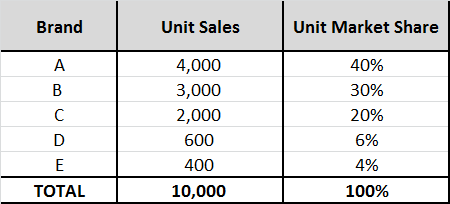- Get the free Excel tool for calculating market shares: market share template
Contents
Market share is a generally easy metric to calculate provided you have access to unit and revenue sales. This is relatively common in a retail setting where the sales information is captured by a point-of-sale terminal on an industry basis.
However, in some industries access to market share information can only be obtained by market research surveys. Obviously the market research survey approach will only provide an estimation of market share, as opposed the capture of real data from consumer purchases.
As suggested by the identical formula, both unit market share and revenue market share are constructed in the same manner. That is, the various sales of each brand listed in the first, and then are totaled.
Each brand’s sales are then divided by the total to determine the percentage market share.
The formula is: Unit Sales of Your Brand / Total Market Size x 100
The following diagram highlights a very simple example for unit market share.
As you can see, there are only five brands in this market and their total unit sales add up to 10,000 units for the period (which could be any specified time period as required).
This table shows that Brand A has 40% market share of units sold (4,000/10,000), where as Brand E has only a 4% unit market share.
And here is another market share calculation example – for unit market share
Let’s assume there are five smartphone brands within the global smartphone market.
The total market size is 500 million units, and the sales data for each brand is as follows:
- Brand A: 100 million units
- Brand B: 80 million units
- Brand C: 120 million units
- Brand D: 70 million units
- Brand E: 130 million units
- Brand A’s unit market share: = (100 million units / 500 million units) x 100 = 20%
- Brand B’s unit market share: = (80 million units / 500 million units) x 100 = 16%
- Brand C’s unit market share: = (120 million units / 500 million units) x 100 = 24%
- Brand D’s unit market share: (70 million units / 500 million units) x 100 = 14%
- Brand E’s unit market share: = (130 million units / 500 million units) x 100 = 26%
In this example – which is a screenshot of the free Excel template – both unit and revenue market shares have been calculated. To make the example easy to follow – the average price per unit is $1 – so the total market unit sales is 20,000 units and the total market revenue is also $20,000.
Firstly, you can see how the market shares are calculated. For example, let’s look at Brand B – their unit sales were 5,000 (out of the 20,000 market total), which is a 25% unit market share – but their revenue market share was 30% ($6,000/$20,000).
Secondly, this example highlights why it is necessary to consider BOTH unit and revenue market share when there are reasonable price differentials in the market. In this example, Brand B prices its products above the market price average – as demonstrated by the price premium metric – whereas Brand C prices itself well below the market average.
And here is another market share calculation example – for revenue market share
Let’s assume there are five smartphone brands within the global smartphone market and that the total market revenue is $1 trillion, and the revenue data for each brand is as follows:
- Brand A: $200 billion
- Brand B: $180 billion
- Brand C: $220 billion
- Brand D: $160 billion
- Brand E: $240 billion
- Brand A’s revenue market share: = ($200 billion / $1 trillion) x 100 = 20%
- Brand B’s revenue market share: = ($180 billion / $1 trillion) x 100 = 18%
- Brand C’s revenue market share: = ($220 billion / $1 trillion) x 100 = 22%
- Brand D’s revenue market share: = ($160 billion / $1 trillion) x 100 = 16%
- Brand E’s revenue market share: = ($240 billion / $1 trillion) x 100 = 24%
Calculating Price Premium
If we continue with the smart phone market example, then because we have BOTH revenue market shares and unit market shares, then we can calculate the price premium index, using this formula:
- Price Premium Index = Revenue Market Share / Unit Market Share
And the price premium index for each brand is:
- Brand A: 20% / 20% = 1
- Brand B: 18% / 16% = 1.125
- Brand C: 22% / 24% = 0.917
- Brand D: 16% / 14% = 1.143
- Brand E: 24% / 26% = 0.923
The price premium index represents the ratio of revenue market share to unit market share. It provides an indication of the premium pricing power of each brand relative to its market share.
A price premium index greater than 1 suggests that the brand is able to generate higher revenue compared to its unit market share, indicating a higher pricing strategy or premium product positioning.
Conversely, a price premium index below 1 suggests a lower pricing strategy relative to market share.
In this example, Brand A has a price premium index = 1, indicating that their pricing aligns with their market share.
Brand B and Brand D have a price premium index slightly higher than 1, suggesting a potential premium pricing strategy. Brands C and E have a price premium index slightly below 1, indicating a relatively lower pricing strategy.
Related Information



